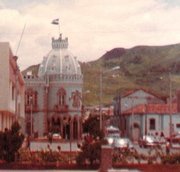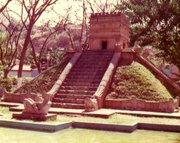Tegucigalpa
|
|
Tegucigalpa, population 897,000 (1997), is the capital of Honduras and the republic's largest city. The city is located in a valley of the same name at Template:Coor dm, and an elevation of 3,250 feet. The name is derived from the amerindian "Tekut Xiuatl Pan" meaning 'Silver Mountain'. Tegucigalpa is also the capital of Honduras' Francisco Morazán Department.
The city's industries include textiles, sugar, and cigarettes. Tegucigalpa was founded in the 16th century, and was a center of silver and gold mining. The capital of the independent Republic of Honduras switched back and forth between Tegucigalpa and Comayagua until it was permanently settled at Tegucigalpa in 1880. It is said that the society of Comayagua, the long time colonial capital of Honduras, publicly disliked the wife of President Marco Aurelio Soto, who took revenge by moving the capital of the republic to Tegucigalpa. Going beyond the public saying, it is most likely that the change of the seat of the capital took place due to the fact that President Marco Aurelio Soto was an important partner of the Rosario Mining Company, whose operations where based in San Juancito, located about 40 km. outside of Tegucigalpa, and he needed to be closer to his personal interests.
The National Autonomous University of Honduras was established here in 1847. The National Museum here has a notable collection of Pre-Columbian artifacts. In the 1930s the town of Comayagüela (on the other side of the Choluteca River from central Tegucigalpa) was incorporated into the city.
The main airport that serves Tegucigalpa is Toncontin International Airport.
The city was significantly damaged by hurricane Mitch in 1998.
Template:CentralAm-geo-stubca:Tegucigalpa de:Tegucigalpa es:Tegucigalpa fr:Tegucigalpa io:Tegucigalpa he:טגוסיגלפה nl:Tegucigalpa ja:テグシガルパ pl:Tegucigalpa pt:Tegucigalpa fi:Tegucigalpa sv:Tegucigalpa


